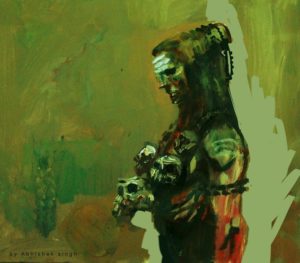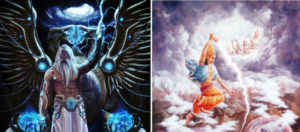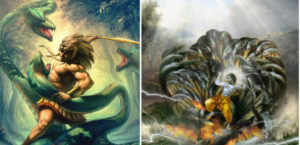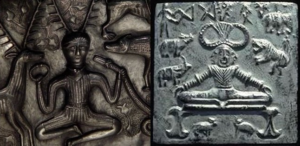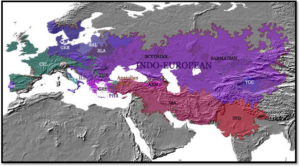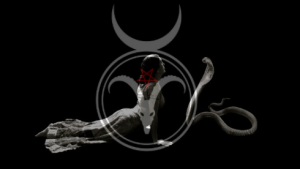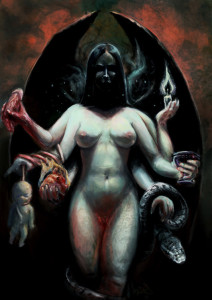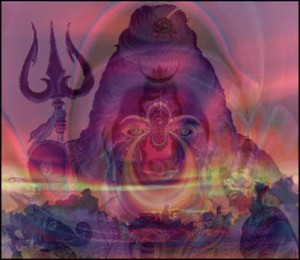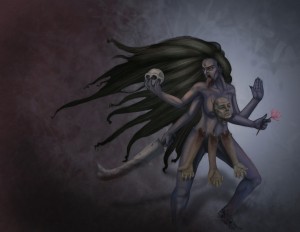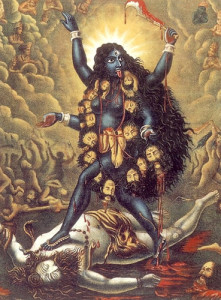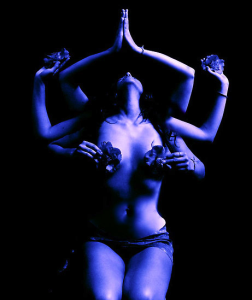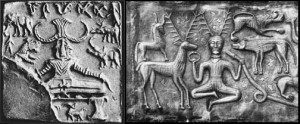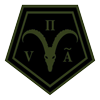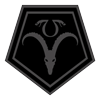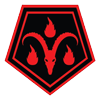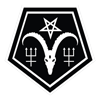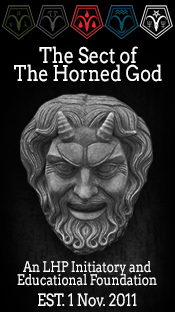Common Roots on the Left-Hand Path
By Thomas LeRoy
“The East/West division dissolves when an understanding is gained concerning the common traditional roots of both branches, which lie in the substrata of Indo-European philosophies. Furthermore, the entirely cross-cultural nature of the left-hand path will become more obvious.”
~ Stephen E. Flowers, Ph.D.
The fifth order in The Sect of the Horned God is called “The Order of Shiva”, and because of this we have been asked as to why we incorporate Eastern Left-Hand Path traditions into our philosophy. Truth be told, the East and West are not as different as you may think based upon the existence of similarities amongst the deities, religious practices and mythologies of the Indo-European peoples. Proto-Indo-Europeans (PIE), the people who gave birth to these common traditions, had a pantheon of gods with similar names and attributes as the gods we are more familiar with. Dyēus Phtēr, for example, was their god of the day-lit sky and the chief god of the Indo-European pantheon. The name survives in Greek with Zeus and the vocative form “Zeu pater”; Latin “Jupiter”.
Consequently, the different branches of Indo-Europeans religions (Greco-Roman, Germanic, and Celtic in Europe, and Hindu, Persian, etc. in Asia), have many similarities:
Zeus and Indra — Not only are they both the “King of the Gods” in their respective mythologies, but their weapons of choice (the lightning-bolt) are the same. In spite of being immortals they resemble human beings for they both show emotions of love, jealousy and anger. Both succumbed to the charms of pious mortal women and impersonated their husbands to seduce them and both of them have many wives.
Hercules and Krishna — Hercules tale of the killing of the Stymphalian Birds, and Lord Krishna killing Bakasura, the bird demon. Hercules capturing the Cretan Bull, and Lord Krishna slaying Arishtasura, the bull demon. Hercules rounding up the horses of Diomedes, and Lord Krishna battling against Keshi, the horse demon.
Cernunnos and Pashupati — The most well known depictions of these two gods, one Celtic the other proto-Indian, shows them horned, seated in a lotus position and surrounded by animals. Pashupati is a “proto-Shiva”, Shiva the Destroyer, the god of the left-hand path in the Hindu tradition.
Even the Celtic Druids and Hindu Brahmins share many similar traits. The Druids, for example, were not simply a priesthood, but were the intellectual caste of ancient Celtic society, incorporating judges, lawyers, medical doctors, ambassadors, historians and so forth, not unlike India’s Brahmin caste. Also, the Druid’s relationship with the tribal king, or ri, was very similar to that of the Brahmin and the raja. On a deeper metaphysical level, they also shared the idea of rebirth and the transmigration of the soul.
“The very name Druid is composed of two Celtic word roots which have parallels in Sanskrit. Indeed, the root vid for knowledge, which also emerges in the Sanskrit word Veda, demonstrates the similarity. The Celtic root dru which means ‘immersion’ also appears in Sanskrit. So a Druid was one ‘immersed in knowledge’.”
~ Peter Beresford-Ellis
Turns out there are many similarities between Old Irish (Celtic) and Sanskrit:
Old Irish – aire (freeman),Sanskrit – arya (noble)
Old Irish – noeb (good), Sanskrit – naib (holy)
Old Irish – bodar (deaf), Sanskrit – badhirah (deaf)
Old Irish – nemed (sacred/privileged), Sanskrit – names (respect)
It has been hypothesized that the spiritual traditions of both East and West are based upon the ancient Indo-European philosophy of “The Eternal Natural Law” (also known as “The Perennial Philosophy”), which emphasizes the aspect that both you and the Divine are one. The Asatru, or Odinists, call it “Örlögr”. In Egypt it was “Ma’at”. In Avestan Persian, “Asha”, and in Sanskrit it is called “Sanatana Dharma”. But in the West the Eternal Natural Law was forced into extinction by the Abrahamic faiths, namely Christianity and Islam, whose dogmas preach that one must seek salvation through subservience to the Divine. And much of what we know of The Eternal Natural Law (which in the West had eventually become known as Witchcraft), is filtered through a warped Abrahamic misunderstanding (examples would be The Malleus Maleficarum, or Compendium Maleficarum, books that set forth much of the modern misconceptions). Many throughout the Western World, though, have attempted to revitalize the old ways. But, whether they realize it or not, it is often based upon the bastardized Christian interpretations. This can obviously be seen in Wicca and other forms of modern paganism, while other revisionists have simply resorted to guesswork and faith. Examples of which would be those attempting to resurrect the Greco/Roman traditions, or the Modern Druids.
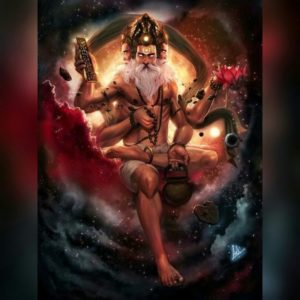
In the East, though, that tradition has remained unbroken for over 5,000 years. The Abrahamic influence did not supplant Sanatana Dharma. Throughout history the Islamists attempted to bring about its demise, but the old ways prevailed. There it need not be resurrected for it never died. In the West, though, there is a chasm separating modernity from the Eternal Natural Law. It is a wide expanse where we see only tiny, distant images on the far side. But there is a bridge across that chasm, secure and steady, and that bridge is Sanatana Dharma.
“An approach via the East will disentangle many of the arguments from the sometimes hopelessly confused jumble we find in the historical sources of the left-hand path in the West.”
~ Stephen E. Flowers, Ph.D.
We in The Sect do not want to guess as to what is maybe happening on the far side of the occult chasm. We don’t want to rely on guesswork and faith. We don’t want to believe.
We want to know.
The Serpent, Lilith and the Kundalini
by Thomas LeRoy
“The daimon of sexuality approaches our soul as a serpent.” — Carl Jung
Serpents play a role in much of the world’s mythological traditions. They can be found on both the left and the right-hand paths, representing life, death, sex, creation and destruction. They symbolize the need for transformation, the chthonic, the female aspect in the unconscious, and also wisdom.
“More especially the threat to one’s inmost self from dragons and serpents points to the danger of the newly acquired consciousness being swallowed up again by the instinctive psyche, the unconscious. The lower vertebrates have from earliest times been favourite symbols of the collective psychic substratum, which is localized anatomically in the subcortical centres, the cerebellum and the spinal cord. These organs constitute the snake. Snake-dreams usually occur, therefore, when the conscious mind is deviating from its instinctual basis.” — Carl Jung, “Archetypes of the Collective Unconscious”, page 166.
Lilith, ancient goddess of the left-hand path, is synonymous with sexual desire and the serpent that suggested Eve eat from the Forbidden Tree. She is a representation of the Great Goddess, a fusion of the carnal with the spiritual. To the ancient Hebrews, though, Lilith was a threat to their patriarchal system and thus they transformed her into a demon. This brought about a division between the male/female duality in the Self, and a suppression of sexual energies, which is still prevalent in all three Abrahamic mythological traditions. But is there a way to return Lilith to her deified status?
In the realm of comparative mythology Lilith is synonymous with the Kundalini, or Shakti, the divine female energy and consort of Shiva. Kundalini is the serpent, coiled at the base of the spine, just as the Serpent was coiled round the Tree of the Knowledge of Sex and Death. She is the first chakra, the root chakra, and is situated at the base of the spine. She is represented by the red Maladhara mandala (root support), the element of fire. The first chakra is the foundation of the physical body; she keeps us grounded. This chakra is the base of the six other Chakras. In some forms of yoga one meditates to awaken the Kundalini so that it will rise up through his/her body. The energy travels upward on a symbolic pathway parallel to the spinal column. As it rises the kundalini activates the chakras in succession. The objective is to raise the Kundalini to the crown chakra, where it unites with Shiva, the male polarity, the Horned God and all his manifestations.
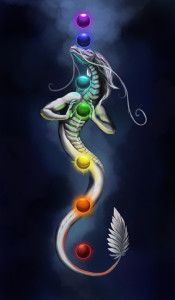
People have had Kundalini-like dreams and visions of serpents throughout all cultures. In terms of Jungian psychology, snake dreams have a powerful archetypal quality. Jung once related the story of a 28-year-old female patient who told him that she had a black serpent in her belly, and that the snake, which had been dormant, had suddenly become “active”. “One day she came and said that the serpent in her belly had moved; it had turned around. Then the serpent moved slowly upward, coming finally out of her mouth, and she saw that the head was golden.” When the woman first told Jung about the snake, he wondered whether she was crazy, but over time he realized that she was simply highly intuitive. She had intuited a typical, or archetypal, image. “Well now, that is a collective symbol,” he said. “That is not an individual fantasy, it is a collective fantasy.” The image of the snake in the abdomen is, of couse, well known in India. Jung said, “The serpent is at the basis of a whole philosophical system, of Tantrism; it is Kundalini, the Kundalini serpent.” Although the woman knew nothing about Kundalini and the tradition was pretty much unknown in the West at the time, Jung said that “We have it too, for we are all similarly human.”
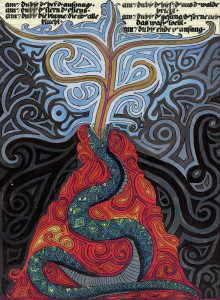
“You see, the Kundalini in psychological terms is that which makes you go on the greatest adventures. …It is the quest that makes life livable, and this is Kundalini; this is the divine urge.” — Carl Jung
Jung believed, though, that arousing the Kundalini had to be spontaneous, and not produced through the dangerous practices of Tantrism. He was not a fan of the left-hand path sexual cults (Too bad!) and never performed any type of formal meditation. But he did see meaning in the motion of the unconscious through Kundalini awakening. The Serpent aspect is not eliminated, or repressed, as it is on the right-hand path. This is one with the alchemical process of transmutation of the base self into something precious. You, your ego, is being elevated to a deified status (self-deification). It is the demon (Lilith) once more becoming the Goddess.
Understanding the Eastern Left-Hand Path Traditions
by Thomas LeRoy
Self-deification is not a proclamation, it is a process. One does not announce to the world that they are a god and henceforth reign supreme over all existence. Self-deification is something you strive to obtain, to reach, and once you have entered that state, you must work to remain there. You are then in a relationship with the deified self, and like any relationship you must work at it. A single slip-up and you can be cast out, back upon the Path, to try once more to re-enter. This is why it is important to have an arsenal of knowledge while proceeding down the Left-Hand Path. Some of you stepped upon the Path for the first time when you picked up The Satanic Bible. But The Satanic Bible was only your introduction. It was a mirror that you saw your reflection in. It was not the conclusion.
Reaching out, searching, learning about other modes of transport to help you down the Path is important. And understanding Eastern LHP philosophy is one way.
In the ancient Hindu traditions the Left-Hand Path, or the vamachara, was originally associated with the female aspect and the heterodox way. To put it simply, it is about reversing the natural spiritual flow. Eventually in the 19th century the Left and Right-Hand Paths were introduced into Western occultism by Theosophy founder Helena Blavatsky when she used them as terms to differentiate between white and black magick. To reach self-deification through the vamachara, or by any other practices, you must have a deep understanding of the Self. Atman, one of the most basic concepts in Hinduism, is the universal Self, identical with the eternal core of the personality. Atman is you, for in the early Vedas (holy Hindu writings) it occurred mostly as a pronoun meaning “oneself”. So atman is that which is then “deified” at the end of the LHP. Brahman, on the other hand, is the Absolute. Brahman underlies the workings of the universe, and atman is part of the universal Brahman. Brahman, in Vedic philosophy, is the “World Soul” and is regarded as being the “Three-in-One God” known as the Trimurti. This consists of Brahma the Creator, Vishnu the Preserver, and Shiva the Destroyer, all manifestations, or personifications, of Brahman.
Shiva, with his wild, unpredictable and destructive nature, is perhaps the ideal personification of the eternal core of the personality, or atman. His violent essence is often conveyed through the use of metaphorical images which are designed to resonate with the subconscious. However, Shiva’s destructive persona is not to be feared. The fury of Shiva’s fire only burns away the walls of ignorance. The atman is indestructible; thus, Shiva’s fire represents the awakening of the Self to its true nature and its god-like status. Because of Shiva’s association with the Self, some Shaivists have rebelled against the standards of the orthodox Hindu community. Believing that Shiva is the Self, they can make their own rules; and since all things, good or bad, are an aspect of the Absolute, nothing is taboo. Thus, they carry out bizarre sacrificial and sexual rituals, eat meat (sometimes human), and use mind-altering intoxicants while chanting “Shivoham!” — “I am Shiva!” They believe these activities to be short-cuts to self-deification. But they are not trying to become one with Shiva. Instead they long to deify the atman to become Shiva. A god!
You practitioners of the Western Left-Hand Path traditions may not have much interest in Eastern Philosophy. It may seem odd and confusing because in the Vedic traditions they attempt to say with words that which can not be said with words. It is metaphorical, it is poetry, and it is meant to be experienced, not critically analysed nor blindly believed. But still it is important that one is aware that there are other deities besides Satan and Lucifer that speak to our inherent nature. And Shiva speaks loudly. If you but only listen.
Kali: The Dark Mother of the Left-Hand Path
“In the Orient, the gods do not stand as ultimate terms, ultimate ends, substantial beings, to be sought and regarded in and for themselves. They are more like metaphors, to serve as guides, pointing beyond themselves and leading one to an experience of one’s own identity with a mystery that transcends them.”
–Joseph Campbell
No image better represents the left-hand path than Kali. For at its roots, the left-hand path is the feminine path. Kali is the ferocious form of the Mother Goddess. She is represented with perhaps the most intense features among all the world’s deities. She has four arms, with a sword in one hand and the head of a demon in another. The other two hands bless all, and say, “Fear not!” She has two dead heads for her earrings, a string of skulls as necklace, and a girdle made of human arms as her clothing.
Kali’s form is replete with awesome symbolism. Her long, wild black hair, flowing freely, depicts her freedom from conformity. Her wide eyes, alert, ablaze with the fury of two molten pits, is an expression of her relentless intensity. A vertical third eye is in the middle of her forehead represents her omniscience. Kali’s black complexion symbolizes her all-embracing, transcendental nature, visualized as a vortex from which all creation emerges and to which it returns.; and her nudity portrays the primal aspects of Nature.
It is said Kali was born from the brow of the Goddess Durga during one of her battles with the evil forces. As the story goes, while in the heat of battle, Kali was so involved in the killing spree, drunk on the blood of her victims, that she got carried away and began destroying everything in sight. To stop her, Lord Shiva threw himself under her feet. Shocked at this sight, Kali stuck out her tongue in astonishment, and put an end to her homicidal rampage. Hence the common image of Kali shows her in her mêlée mood, standing with one foot on Shiva’s chest, with her enormous tongue sticking out.
As Kali danced upon Shiva, it evolved into a sexual act. She straddled him; she being on top, taking control. Shiva became the passive one. He satiated her desire by offering her sex in which she was in control. He was acted upon, for if Shiva had not given in to Kali, she would have destroyed the world.
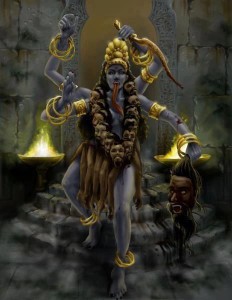
On the left-hand path it is necessary to enter the spontaneous chaos that is our true nature by breaking taboos, and shattering the chains of slave morality. Kali is there to help. She is the great liberator, representing the consuming aspects of reality, but burdened with the task of bringing about self-actualization. One does not worship her, but instead enacts with her divinity from a subjective perspective. But with Kali we risk madness when we let go of the familiar setting of our self-prescribed limitations. In this madness, Kali simultaneously creates and destroys, intoxicated with the paradox that death feeds on life, and life feeds on death — the eternal Wheel of Time. She is in the waning and waxing of the moon, the turning of the seasons, the shedding of the old self for the new, these are all part of her feminine rhythms. Her healing and empowering energy is not just for women, though, but for men as well. Embracing this dark manifestation of the anima shatters illusions and reveals that the repressed feminine aspects regarded as weak, irrational, chaotic, or emotional, are in truth, powerful tools to help lead one to self-deification.
Shiva the Destroyer: Lord of the Left-Hand Path
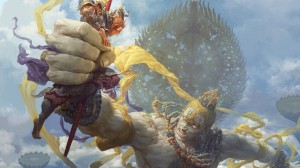
by Thomas LeRoy, Founder of The Sect of the Horned God
There are many mythological gods and entities on the left-hand path. Lord Shiva is but one. Though not always viewed through the lens of the LHP, he is, in some manner, the greatest of these deities.
Shiva is one of the most important gods in the Hindu tradition and, along with Brahma and Vishnu, is one-third of the holy trinity of Hinduism. A deity of great complexity, he is often represented as a lord of love, light and protection. But he also has a darker side. Shiva the Destroyer is the leader of evil spirits, ghosts, vampires, along with being the master of thieves and villains. He destroys the universe at the end of each cycle (every 2,160,000,000 years) which then allows for a new Creation. His destructive powers are often terrible, but they also have a positive side in that destruction usually leads to new and better forms of existence. Shiva destroys in order to create, since death is the medium for rebirth into a new life. It is common to see Shiva depicted with four arms and three eyes. A glance from the third eye in the center of his forehead has the power to destroy anything in creation, including humans and gods. In this destroyer role he often lurks the cremation grounds, a serpent representing Kundalini coiled around his neck, along with a necklace of skulls. And it is not uncommon for him to be accompanied by a band of terrifying demons, hungering for blood.
Shiva seems to have a connection to the deities of Western traditions through an ancient horned god of the Indus Valley, a “proto-Shiva”, called Pashupati. In the Skanda Purana it tells how Pashupati used to find calm in a forest called the “Sleshmantaka” . It was here that he spent time being immersed in “the wilderness of this forest.” Depicted seated in a lotus position surrounded by animals, Pashupati had a striking resemblance to Cernunnos, horned god of the Celts, but there is a 3,000 year old gap, between these two gods (Pashupati dating from about 3,000 B.C.). Is this an example of racial memory, the collective unconscious, or do they both stem from a long forgotten Indo/European horned god? It is a mystery to be pondered, but what is also interesting is Cernunnos has been, over time, transformed into an incarnation of Satan, supreme lord of the Western left-hand path traditions, while Pashupati has morphed into Shiva, lord of the Eastern.
Shiva the Destroyer is the most ancient and powerful of all LHP deities. He is the ultimate adversary, adversarial to those aspects of the self that keep one from progressing upon the path. Shiva and the other beings of a mythological nature are not to be believed as objective truths, nor are they to be shunned as lies. They are to be experienced, experienced within the soul/psyche as meaningful poetry of the subconscious.
To meditate upon the image of Shiva,
to utilize the metaphor, to find calm in the symbol that is the deity,
does not make one a Hindu.
Just as contemplating on the image of Satan, does not make one a Hebrew.
